Abstract
Traditional measurement and recording methods are inadequate for continuous monitoring of ambulatory pulmonary artery pressure. Therefore a new miniaturised solid state system has been developed and assessed. A manometer tipped catheter, inserted via a subclavian or cephalic vein, was used together with an isolated amplifier and peak detectors to determine systolic and diastolic pressures. Pressures were averaged over 30 seconds and stored in digital memory. After a 24 hour recording period data were rapidly transferred to a microcomputer for numerical or graphical display. Thirteen patients had continuous ambulatory monitoring performed for between 24 and 96 hours, in seven to evaluate symptoms of dyspnoea in subjects with valvular or coronary disease (group 1), and in six to achieve optimal oral treatment for left heart failure (group 2). The catheter was calibrated before insertion and was rechecked after removal. There was less than 1% zero level drift and similar gain stability. Systolic pressures ranged from 10 to 97 (mean 39.5) mmHg, and diastolic from 1 to 46 (mean 15.3) mmHg. Four patients in group 1 had symptoms of dyspnoea associated with normal pressures, while three had raised pressures. Four of the six patients monitored in group 2 had major alterations in their treatment based on data obtained during monitoring. There were no complications. This system, which allows safe, reliable, and prolonged recording of ambulatory pulmonary artery pressure, represents a considerable advance in the ability to assess the cause of dyspnoea and to manage left heart failure.
Full text
PDF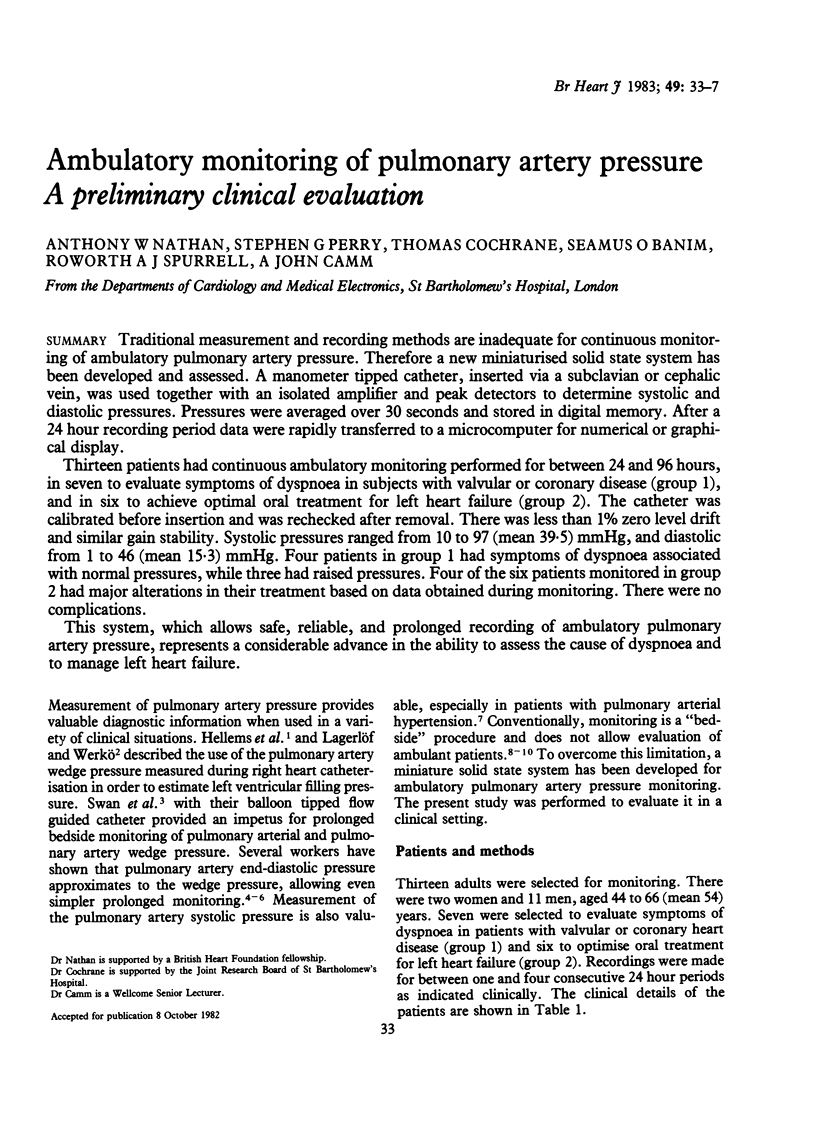
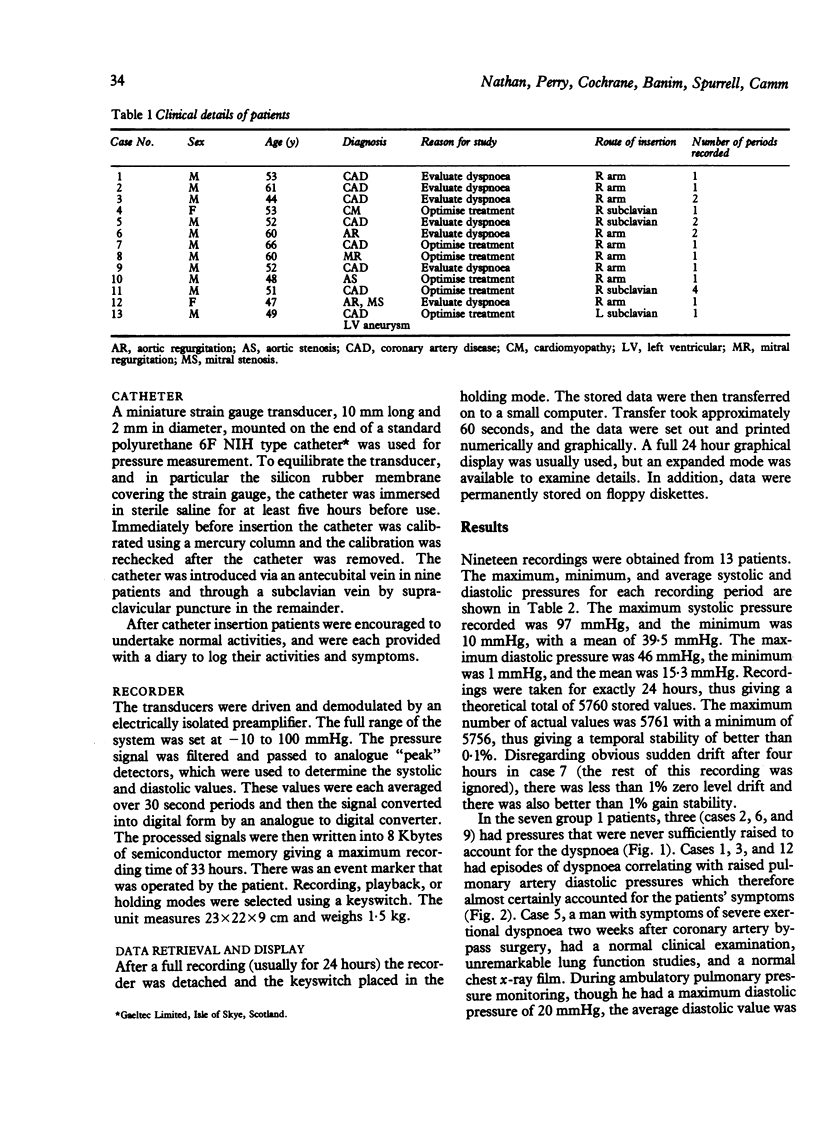
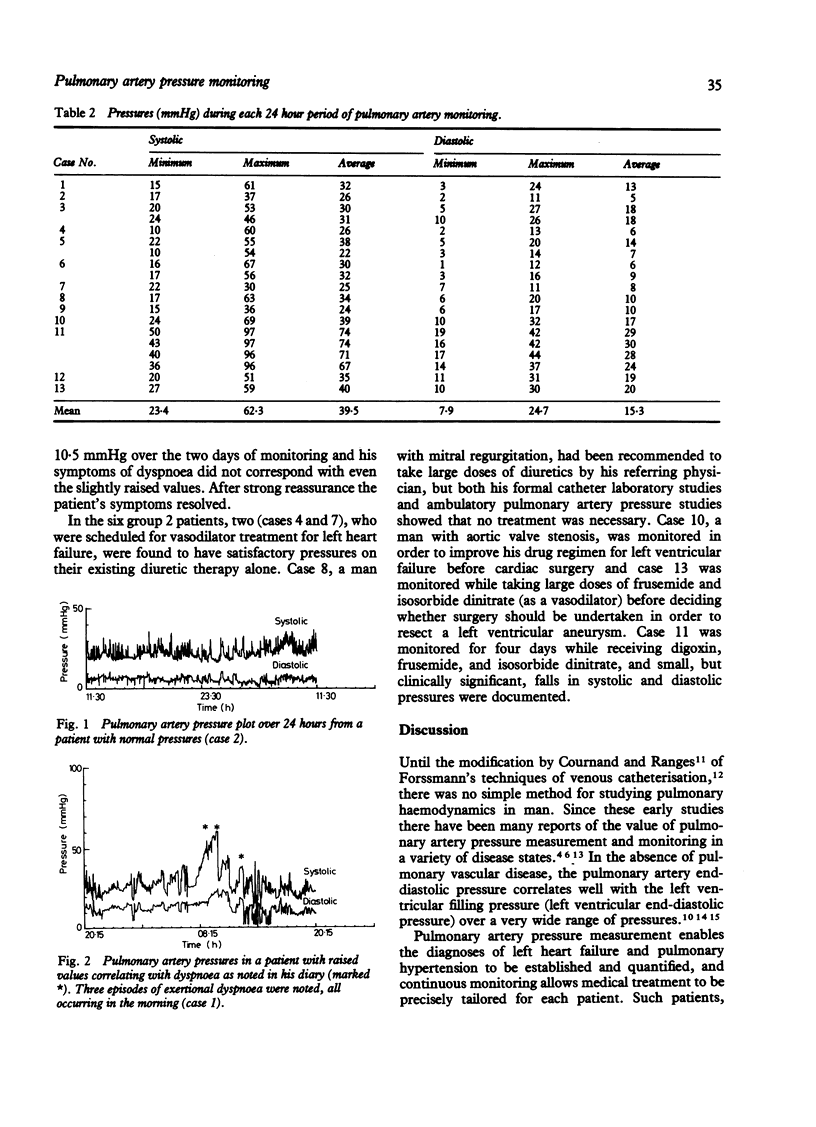
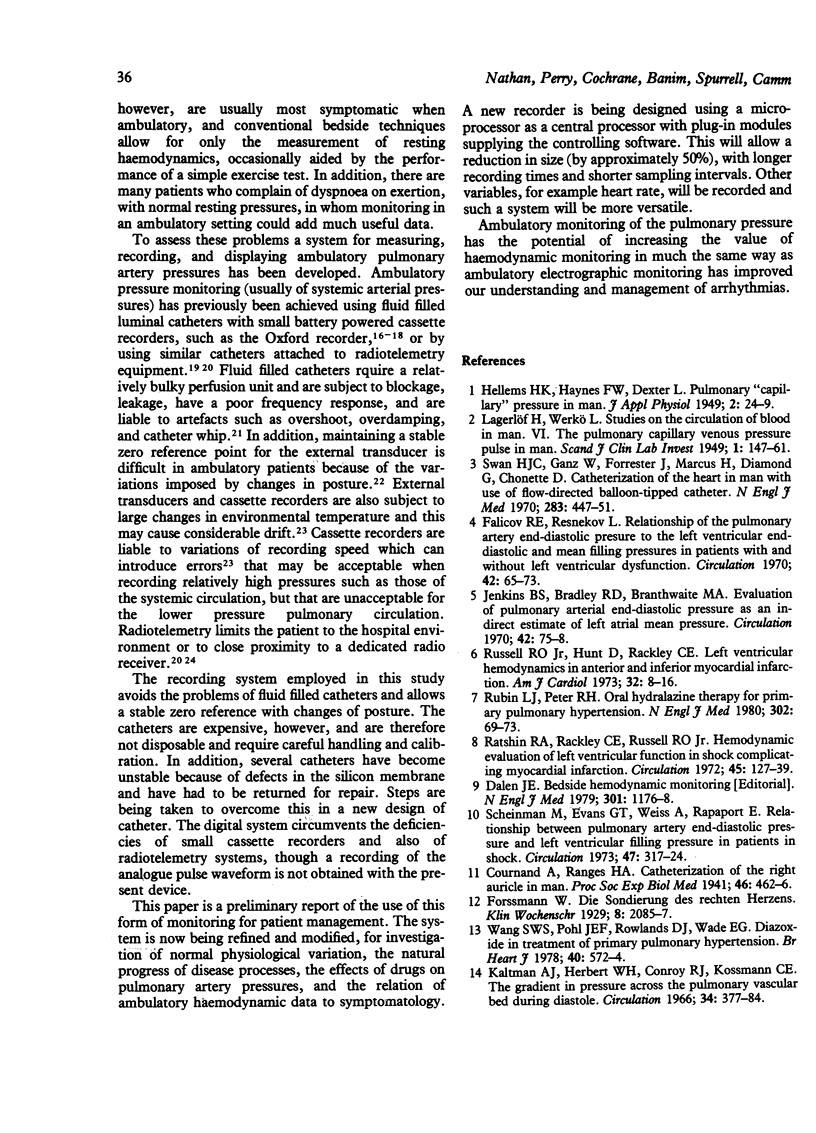
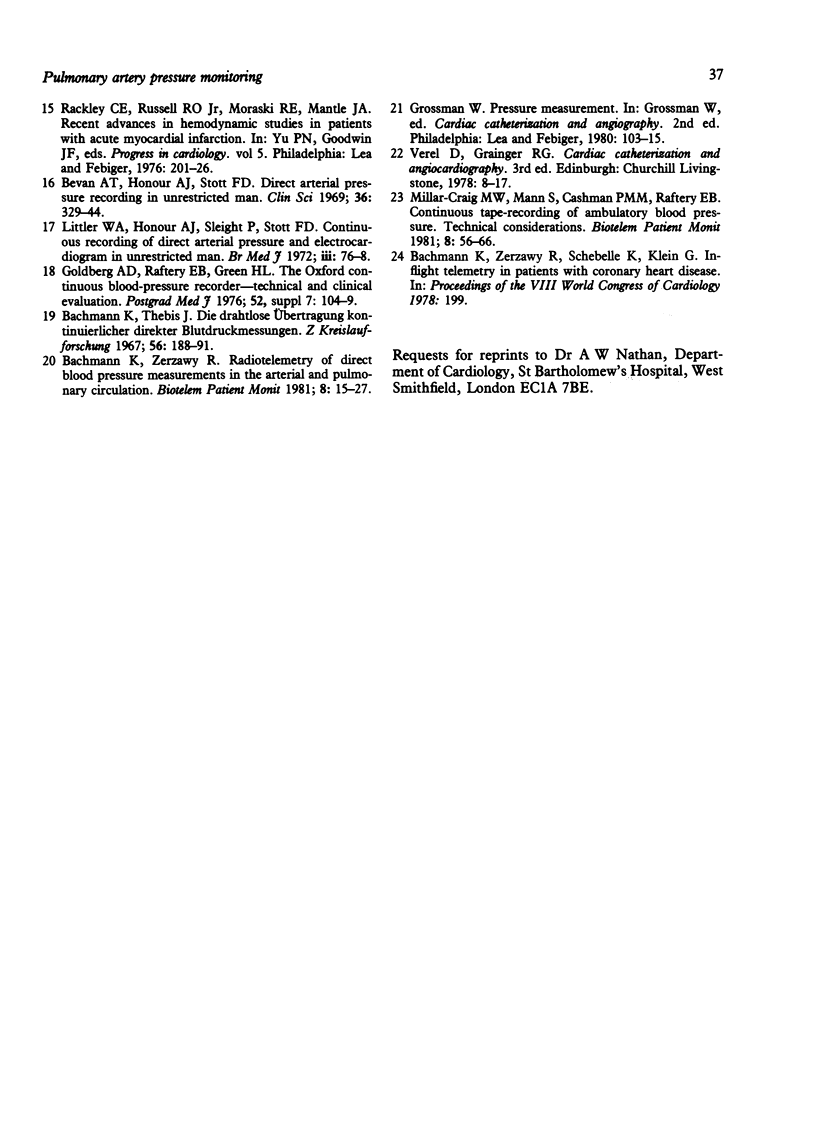
Selected References
These references are in PubMed. This may not be the complete list of references from this article.
- Bachmann K., Zerzawy R. Radiotelemetry of direct blood pressure measurements in the arterial and pulmonary circulation. Biotelem Patient Monit. 1981;8(1-2):15–27. [PubMed] [Google Scholar]
- Bevan A. T., Honour A. J., Stott F. H. Direct arterial pressure recording in unrestricted man. Clin Sci. 1969 Apr;36(2):329–344. [PubMed] [Google Scholar]
- Dalen J. E. Bedside hemodynamic monitoring. N Engl J Med. 1979 Nov 22;301(21):1176–1178. doi: 10.1056/NEJM197911223012110. [DOI] [PubMed] [Google Scholar]
- Falicov R. E., Resnekov L. Relationship of the pulmonary artery end-diastolic pressure to the left ventricular end-diastolic and mean filling pressures in patients with and without left ventricular dysfunction. Circulation. 1970 Jul;42(1):65–73. doi: 10.1161/01.cir.42.1.65. [DOI] [PubMed] [Google Scholar]
- Goldberg A. D., Raftery E. B., Green H. L. The Oxford continuous blood-pressure recorder--technical and clinical evaluation. Postgrad Med J. 1976;52 (Suppl 7):104–109. [PubMed] [Google Scholar]
- Jenkins B. S., Bradley R. D., Branthwaite M. A. Evaluation of pulmonary arterial end-diastolic pressure as an indirect estimate of left atrial mean pressure. Circulation. 1970 Jul;42(1):75–78. doi: 10.1161/01.cir.42.1.75. [DOI] [PubMed] [Google Scholar]
- Kaltman A. J., Herbert W. H., Conroy R. J., Kossmann C. E. The gradient in pressure across the pulmonary vascular bed during diastole. Circulation. 1966 Sep;34(3):377–384. doi: 10.1161/01.cir.34.3.377. [DOI] [PubMed] [Google Scholar]
- Millar-Craig M. W., Mann S., Cashman P. M., Raftery E. B. Continuous tape-recording of ambulatory blood pressure. Technical considerations. Biotelem Patient Monit. 1981;8(1-2):56–66. [PubMed] [Google Scholar]
- Ratshin R. A., Rackley C. E., Russell R. O., Jr Hemodynamic evaluation of left ventricular function in shock complicating myocardial infarction. Circulation. 1972 Jan;45(1):127–139. doi: 10.1161/01.cir.45.1.127. [DOI] [PubMed] [Google Scholar]
- Rubin L. J., Peter R. H. Oral hydralazine therapy for primary pulmonary hypertension. N Engl J Med. 1980 Jan 10;302(2):69–73. doi: 10.1056/NEJM198001103020201. [DOI] [PubMed] [Google Scholar]
- Russell R. O., Jr, Hunt D., Rackley C. E. Left ventricular hemodynamics in anterior and inferior myocardial infarction. Am J Cardiol. 1973 Jul;32(1):8–16. doi: 10.1016/s0002-9149(73)80080-3. [DOI] [PubMed] [Google Scholar]
- Scheinman M., Evans G. T., Weiss A., Rapaport E. Relationship between pulmonary artery end-diastolic pressure and left ventricular filling pressure in patients in shock. Circulation. 1973 Feb;47(2):317–324. doi: 10.1161/01.cir.47.2.317. [DOI] [PubMed] [Google Scholar]
- Swan H. J., Ganz W., Forrester J., Marcus H., Diamond G., Chonette D. Catheterization of the heart in man with use of a flow-directed balloon-tipped catheter. N Engl J Med. 1970 Aug 27;283(9):447–451. doi: 10.1056/NEJM197008272830902. [DOI] [PubMed] [Google Scholar]
- Wang S. W., Pohl J. E., Rowlands D. J., Wade E. G. Diazoxide in treatment of primary pulmonary hypertension. Br Heart J. 1978 May;40(5):572–574. doi: 10.1136/hrt.40.5.572. [DOI] [PMC free article] [PubMed] [Google Scholar]


